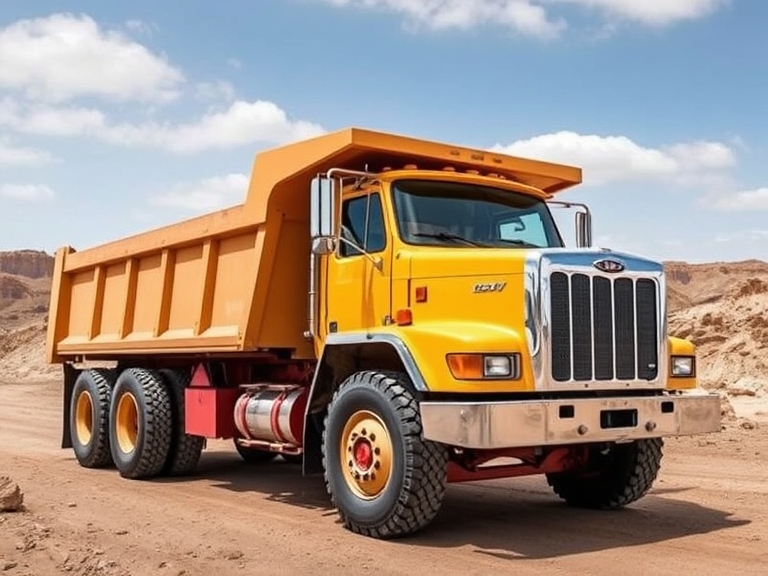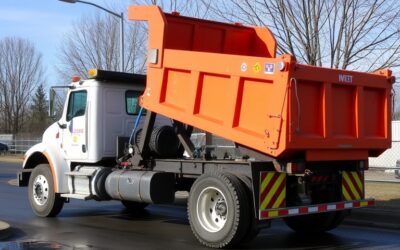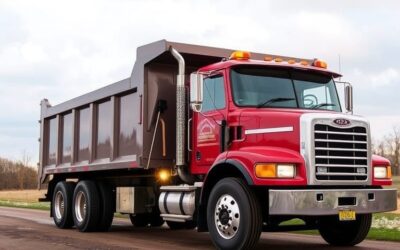Keeping dump trucks stable is essential for safe, efficient operations. Tipping accidents can cause delays, damage, and injuries—but simple practices like proper loading, safe driving, and regular maintenance can prevent them. Whether you work in construction, mining, or waste management, a stable truck ensures that your tasks are completed without accidents or delays. One of the biggest challenges is preventing the truck from tipping over, which can cause severe damage and even injuries. By following best practices, you can maintain balance and stability. Loading your dump truck properly is the first step to ensuring it remains steady. Uneven loads can shift during transport, leading to dangerous situations. It’s crucial to distribute the load evenly and secure it properly. This not only helps keep the truck balanced but also makes driving safer and smoother.
In addition to proper loading, how you drive the dump truck plays a significant role in maintaining stability. Taking sharp turns or driving over uneven terrain can easily destabilize the vehicle. By adopting safe driving practices and being mindful of the truck’s limitations, you can reduce the risk of tipping.
Regular maintenance and inspections are also essential. Checking the truck’s systems and components frequently helps catch any potential issues before they become serious problems. It ensures that the truck runs smoothly and remains stable under heavy loads.
Proper Loading Techniques to Maintain Balance
Loading a dump truck correctly is one of the most critical steps to keep it stable. When loads are unevenly distributed, the risk of tipping increases dramatically. Here are some essential tips for proper loading:
1. Even Distribution: Distribute the load evenly across the truck bed to maintain balance and prevent dangerous shifts during transport. Avoid piling materials on one side, as this creates an imbalance. Even distribution helps maintain the truck’s center of gravity.
2. Centering the Load: Place the heaviest materials in the center to keep the truck’s center of gravity stable, especially on turns or uneven surfaces. This helps evenly disperse the weight and reduces the chances of tipping when making turns or driving over uneven surfaces.
3. Securing the Load: Secure the load with straps, chains, or netting to avoid dangerous shifts that can destabilize the truck. Use straps, chains, or netting to hold materials in place. Load shifts can cause sudden movements that destabilize the truck.
4. Avoiding Overloading: Stick to the manufacturer’s weight limits to prevent strain on suspension and maintain control. Overloading puts extra stress on the truck’s suspension and can make it harder to control. Check the manufacturer’s guidelines for maximum load limits.
5. Layering Materials: Layer heavier materials at the bottom and lighter ones on top to keep the center of gravity low and balanced. Place heavier items at the bottom and lighter materials on top. This helps maintain a lower center of gravity.
By following these loading practices, you help ensure that your dump truck remains stable throughout its journey.
Essential Driving Tips for Stability
Driving a dump truck requires careful attention to maintain stability, especially when carrying heavy loads. Implement these tips to drive safely and keep your truck steady:
1. Smooth Maneuvering: Make wide, gradual turns to keep the load stable and prevent tipping. Make wide, gradual turns to prevent the load from shifting or the truck from tipping over.
2. Mind the Speed: Adjust your speed to the terrain and load weight. Slow down on uneven surfaces or in bad weather. Slow down when driving on uneven terrain or in bad weather. High speeds increase the risk of losing control.
3. Brake Gently: Brake gently to avoid sudden load shifts. Anticipate stops and decelerate early for better control. Sudden braking can cause the load to shift forward, resulting in instability. Anticipate stops and start braking early.
4. Watch for Potholes: Navigate around potholes and rough surfaces whenever possible to avoid destabilizing jolts. These can cause sudden jolts that may destabilize the truck. Navigate around obstacles when possible.
5. Use Lower Gears: Shift to lower gears on inclines and declines to maintain control and reduce brake strain.
6. Remain Alert: Stay focused and take regular breaks to prevent fatigue. Alert drivers make safer decisions. Fatigue can impair your ability to react quickly to changes in the road or load conditions. Take regular breaks to stay sharp.
Following these driving tips can greatly reduce the risk of accidents and help keep your dump truck steady. By combining proper loading and careful driving, you create a safer working environment for yourself and others.
Importance of Regular Maintenance and Inspections
Regular maintenance and inspections are crucial to keep your dump truck in top condition and ensure it remains stable. By routinely checking your truck, you can spot and fix issues before they become serious problems. Here are some essential maintenance tips:
1. Check Tire Pressure: Properly inflated tires provide better stability and control. Underinflated or overinflated tires can cause uneven wear and reduce the truck’s balance. Check tire pressure regularly and adjust as needed.
2. Inspect Suspension System: The suspension system supports the truck’s load and absorbs shocks from the road. Regularly inspect it to ensure all components are in good working order. Replace any worn-out parts to maintain stability.
3. Brake System: The brakes are vital for controlling the truck, especially when carrying heavy loads. Regularly check brake pads, rotors, and fluid levels. Address any signs of wear or malfunction immediately.
4. Hydraulic System: For trucks with hydraulics, ensure there are no leaks and that all components are functioning correctly. The hydraulic system plays a crucial role in load management and stability.
5. Lighting and Signals: Make sure all lights and signals are functioning. Proper lighting is essential for safe driving, especially in low-visibility conditions.
6. Routine Lubrication: Lubricate all moving parts regularly. This reduces friction and wear, ensuring that components work smoothly and efficiently.
By keeping up with regular maintenance and inspections, you can ensure that your dump truck operates safely and remains stable during all tasks.
Advanced Technologies to Enhance Dump Truck Stability
- Automatic Lowering Systems, like Wink Anti-Tip, lower the truck’s center of gravity during instability, actively preventing tip-overs.
- Real-time load sensors detect imbalances and alert drivers immediately, allowing corrective action before instability occurs.
- Stability control systems automatically adjust braking and speed, keeping the truck balanced on uneven terrain.
- GPS and telematics systems provide real-time data on road conditions and truck performance, improving route safety.
- Inclination sensors monitor angles and notify drivers of dangerous slopes, helping prevent accidents.
Conclusion
Keeping dump trucks steady requires proper loading, safe driving, regular maintenance, and advanced technologies like Wink Anti-Tip. By following these practices, you can prevent tipping, ensure safety, and keep operations running smoothly. By following best practices in these areas, you can significantly reduce the risk of tipping and ensure a safer work environment. Properly distributing the load, driving smoothly, and keeping up with inspections are fundamental steps towards stability. Additionally, embracing advanced technologies can provide extra layers of safety and control, making your operations more efficient.
Stability and safety should always be top priorities when operating heavy-duty trucks. By taking proactive measures, you can avoid accidents, reduce downtime, and protect both your equipment and your team.
Ready to enhance the stability and safety of your dump truck? Discover the innovative anti-tipping device solutions from Wink Anti-Tip to keep your truck steady and secure.





